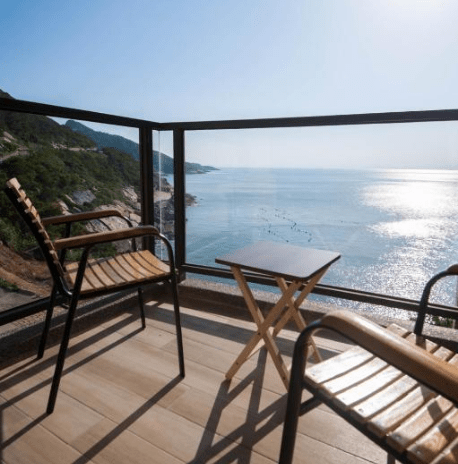Exploring Traditional Villages, War History, Slow Living, and Scenic Beaches Close to Mainland China
Text | Rick Charette
Photos | Chen Cheng-kuo
Rich military history + traditional architecture + cycling/scootering excursions + birdwatching & eco-touring = the “Golden Gate”
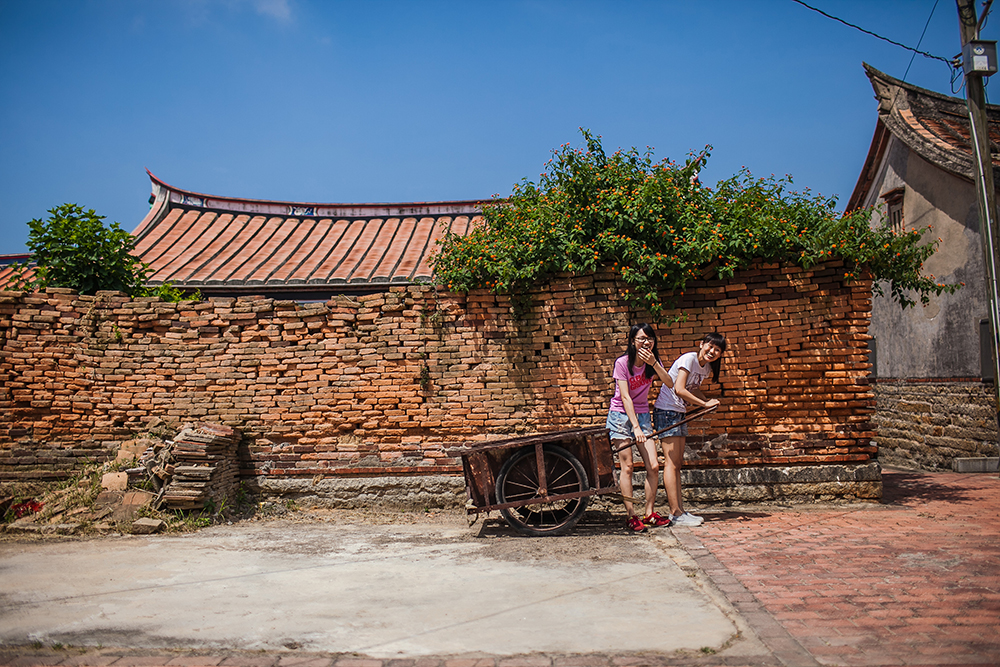
Everyone in Taiwan knows of the Golden Gate. No, not the bridge. Taiwan has its very own Golden Gate, an archipelago directly off the China mainland. For historical reasons the official transliteration of the “golden gate” characters is “Kinmen,” rather than the standard-use Hanyu Pinyin “Jinmen.”
Kinmen is of Taiwan, yet not. Twelve of the 15 islands are controlled by the Republic of China (Taiwan). The islands are, geologically speaking, part of China’s Fujian Province rather than of the island of Taiwan, and both the ROC and PRC refer to them in this way. The two largest ROC-controlled islands, Kinmen and Little Kinmen (Lieyu), have become popular tourist destinations in the past two decades. Recently, I visited the larger of the two, the former, with a Travel in Taiwan crew – my first time in, using a local expression, the “garden built on a granite fortress.”
Jincheng & Environs
The best way to get around the island is by scooter. The terrain is comparatively flat, the roads are excellent, population density is low, roads are sleepy, and locals drive noticeably slowly. There is good tree cover and much shade along routes, especially on and around rocky Mt. Taiwu (just 253 meters high), and the island’s just-offshore location results in frequent cooling breezes. We picked up our scooter-steeds right outside the airport terminal and headed for Jincheng, the quiet main town, which is often the first stop for tourists. Kinmen is shaped like a bowtie, and coast-side Jincheng is in the middle of the western section.
The name Kinmen is about 600 years old. “Golden Gate” refers to protective walls raised in the 1380s where Jincheng today stands, meant to repel pirate attack. The term is best understood as meaning an imposing gateway that could not be breached. The name Jincheng is literally “jin = golden” and “cheng = city, city wall.”
The archipelago was under martial law and heavily garrisoned from the late 1940s into the early 1990s. Since being opened to outside visitors, tourism facilities on Kinmen and Little Kinmen have been systematically built up, and the quaint old section of Jincheng is today an attractive destination. Two main attractions are narrow Mofan Street and the wide, imposing Memorial Arch to Qiu Liang-gong’s Mother.
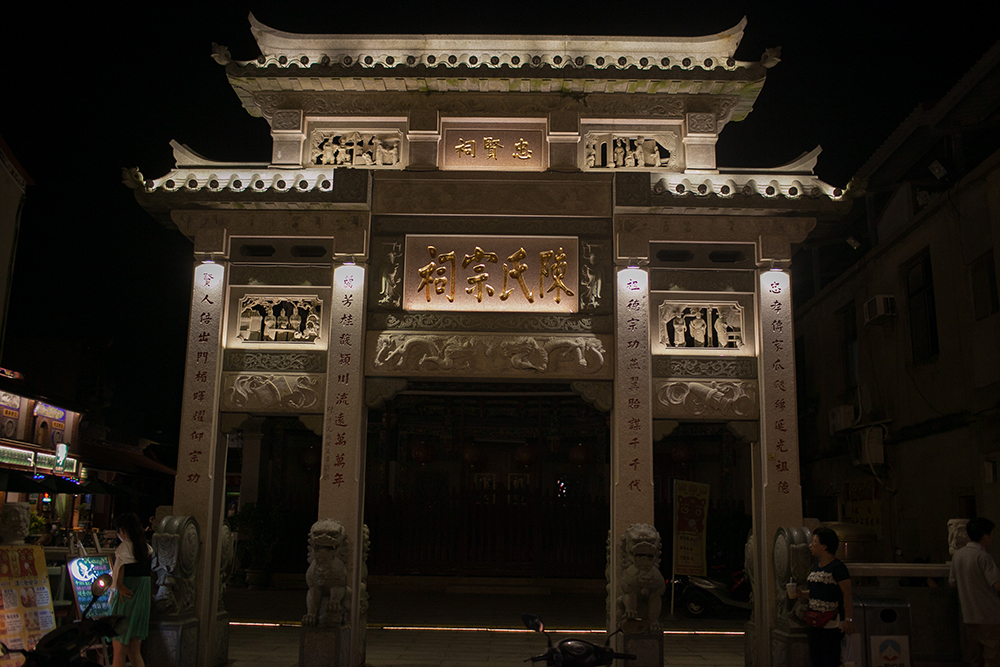
Charming, flagstoned Mofan Street, lined with red brick-faced souvenir shops and eateries, was built in 1925 in the arcaded Southeast Asia style by returning Kinmen businessmen who had made trading fortunes there. Filial piety and ancestor worship are two of the defining features of Han Chinese culture, and the memorial arch is a well-known example of its expression. Built in 1812 by a governor of China’s Zhejiang Province who was a native son of Kinmen, the arch honors his Mom’s chastity – the chaste but likely quite lonely woman lived on 28 years without remarrying after her husband passed on, in accordance with ancient custom. Refined craftsmanship brings elegance to the high-grade stone, including four auspicious lions at pillar bases staring back at you.
Kinmen’s most visited tourist site, the three-story Juguang Tower was built in 1952 to honor all soldiers that have given the ultimate sacrifice in defending the islands. On a hill just south of and overlooking the town, it has displays on such Kinmen topics as food, architecture, wind lions, City God celebrations, and the tower itself. The environment is very pleasant – the stone-base tower has a faux palace in the classical-Chinese style for its third storey, and is surrounded by sculpted, tree-shaded gardens.
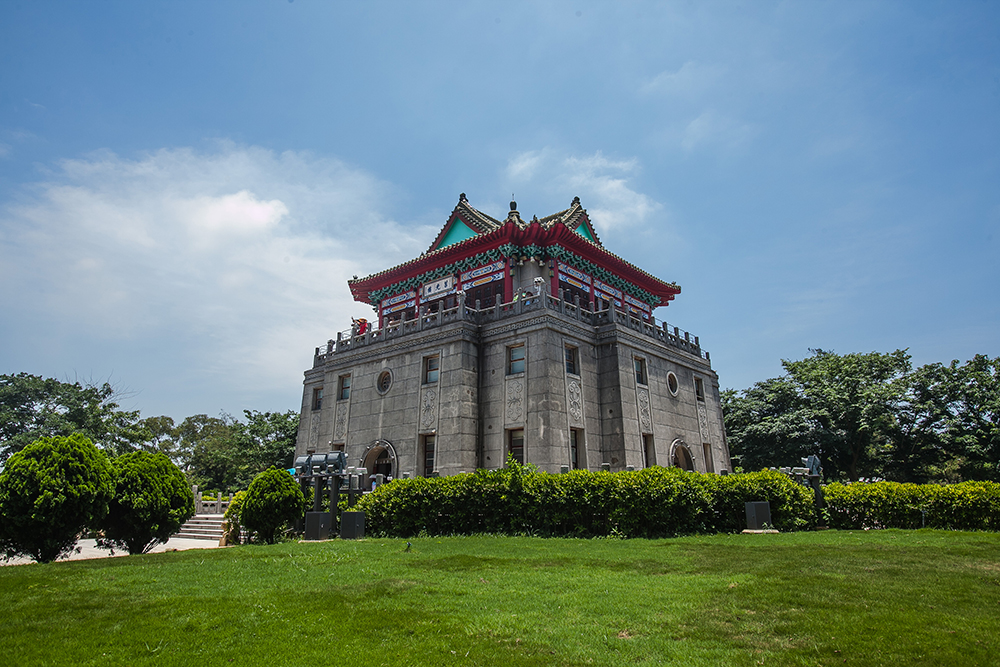
Down below the tower, offshore in a wide, sweeping bay, is small Jiangong Island, which can be accessed from the pleasant coastal park at this location. One of the most likeable works of public art I have ever come across is here. At high tide, four steel-frame silhouette sculptures of oystermen with conical hats seem to stand on the water. At low tide, a narrow, shell-encrusted granite-slab causeway magically appears on the mud flats, busy with marine life, leading to the island, the oystermen appearing as though walking in mid-air above it. The clever work makes the sunsets over the island even more artistic.
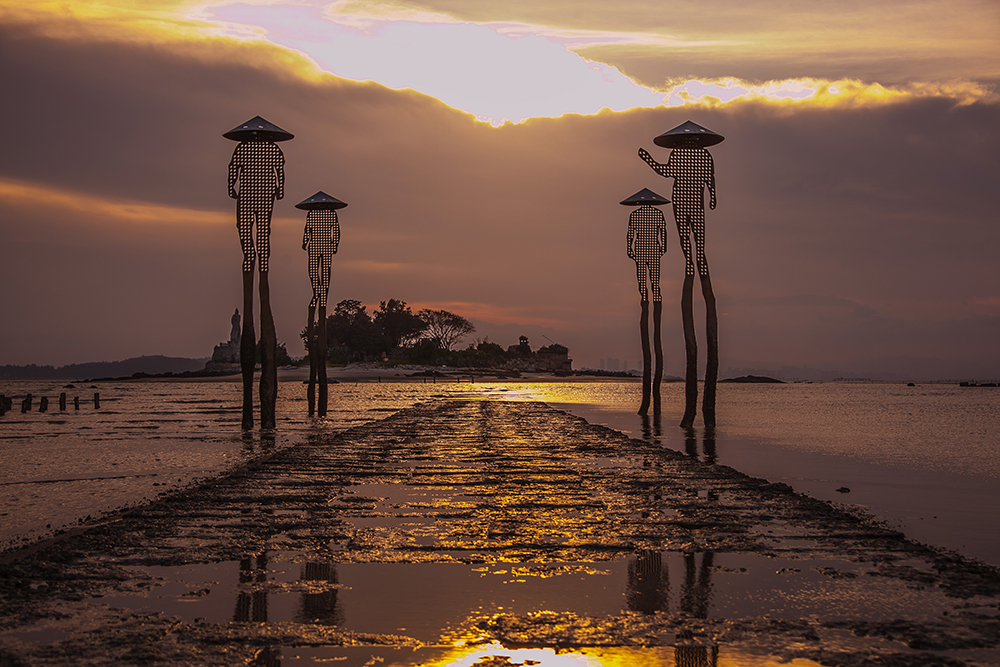
Heritage Architecture
Kinmen’s long period of martial law and heavy garrisoning froze the islands in economic time. An inadvertent benefit was that its rich trove of traditional architecture was preserved, to the delight of today’s tourists. Its collection of south Fujian architectural works is perhaps the finest in existence, and there are many still-intact clan villages. Much government-supported fixing up has been undertaken. Most visited is Shanhou Folk Culture Village, built in 1900, which has the look and feel of a museum showcase. I also especially liked the villages of Nanshan, Beishan, Shuitou, Qionglin, and Oucuo, which are very much community places, with residents busying themselves doing laundry, chatting, and so on.
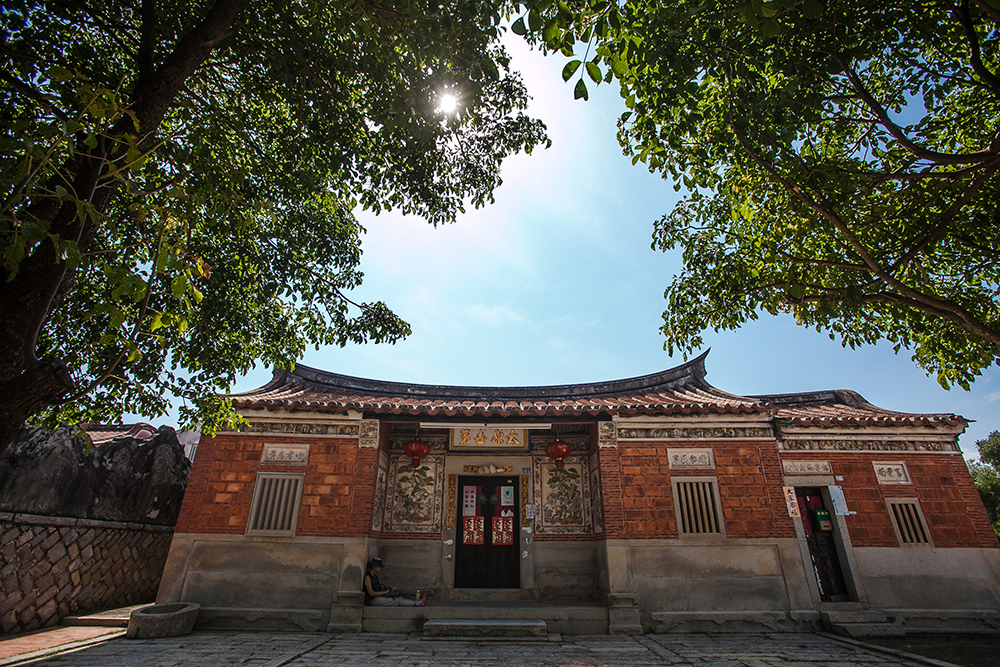
Kinmen is also home to more than 100 Western-style colonial mansions, most built in the late 1800s and early 1900s by returning local traders who had struck it rich in Southeast Asia and Japan. Many have been converted into homestays and cafés/souvenir shops. The two most intriguing, and best-known, are the Beishan Old Western-style House and Shuitou’s Deyue Mansion. The first was commandeered as a command post by the Red forces during the 1949 Guningtou fighting (see Guningtou museum entry); today abandoned, it looks like a backdrop for a war-movie set, but sports bullet holes and blasted-out scars that are remnants of something fearsomely real. The second, which has a pink façade and distinctive gun tower once Kinmen’s tallest structure, has a welcoming courtyard souvenir shop and balconied café.
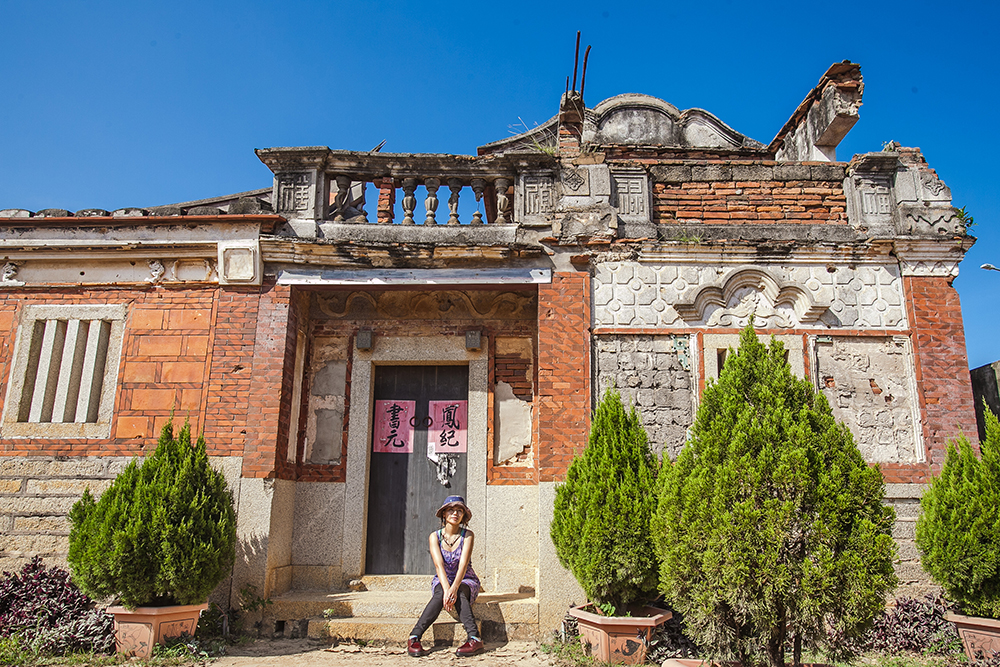
The Northwest Part
Having overnighted at a comfy homestay in the northwest, our first stop the next day was nearby Lake Ci. This large saltwater lake, cornerstone of Kinmen’s largest wild-bird habitat (there are display boards with good English), was formed when the military closed off a bay by building a long causeway. Augmenting the photo opps here is a line of decommissioned tanks with turrets dramatically pointed at Xiamen, and an abandoned bunker-type fort now open to tourists.
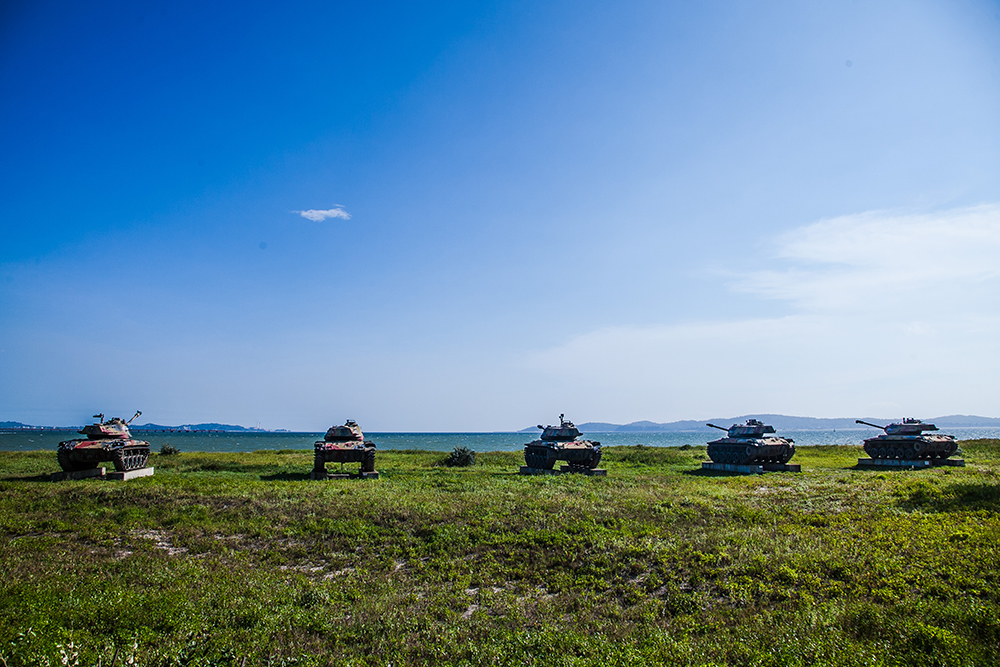
On the inland side the lake is surrounded by a network of fish farms, marshes, and small reservoirs. By quiet Shuangli Lake is the bright and airy Shuangli Wetlands Nature Center, which has informative displays on the local ecology with good English. What I liked best about this place, however, was the basement-level café/eatery, which has large windows that let you view the action both above and below the surface in the adjoining marsh.
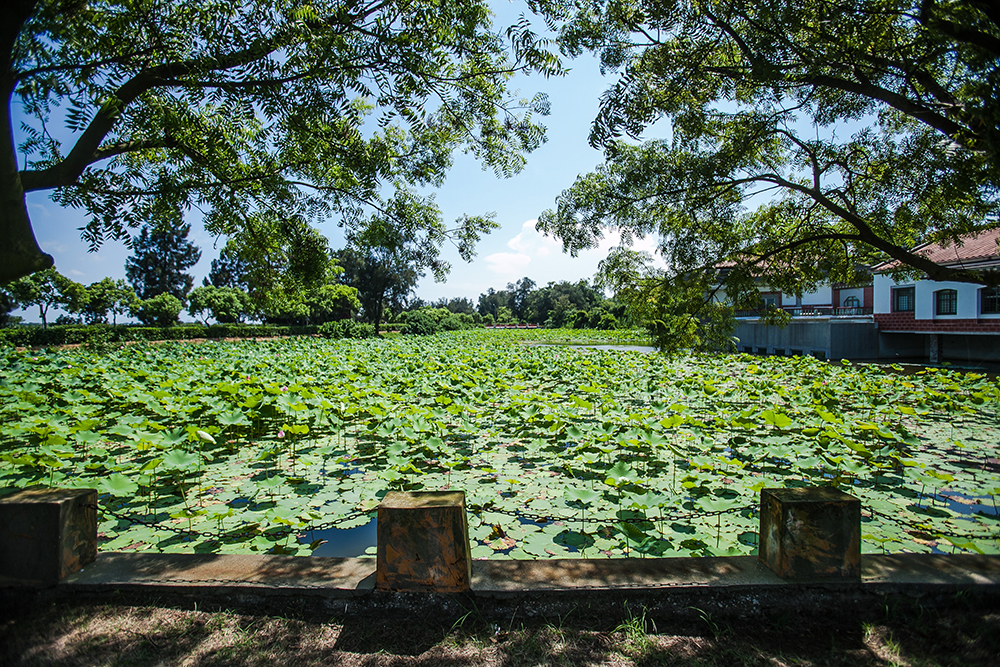
On October 25, 1949 Communist forces stormed the beaches and inland areas at Guningtou. After 56 hours of full-scale slaughter the Red forces surrendered, routed, with 12,000 dead. The Guningtou Battle Museum, opened in 1984, has enough battle-related documentation and photos to make war buffs giddy. The choicest morsels, however, are the “Kinmen Bears” on display, the U.S.-supplied M1 A1 tanks that played such a decisive role in this live-and-make-die struggle. I best enjoyed the tunnels that take you to fortified beachfront positions, where countless young men spent long hours, lonely and anxious and far from home.
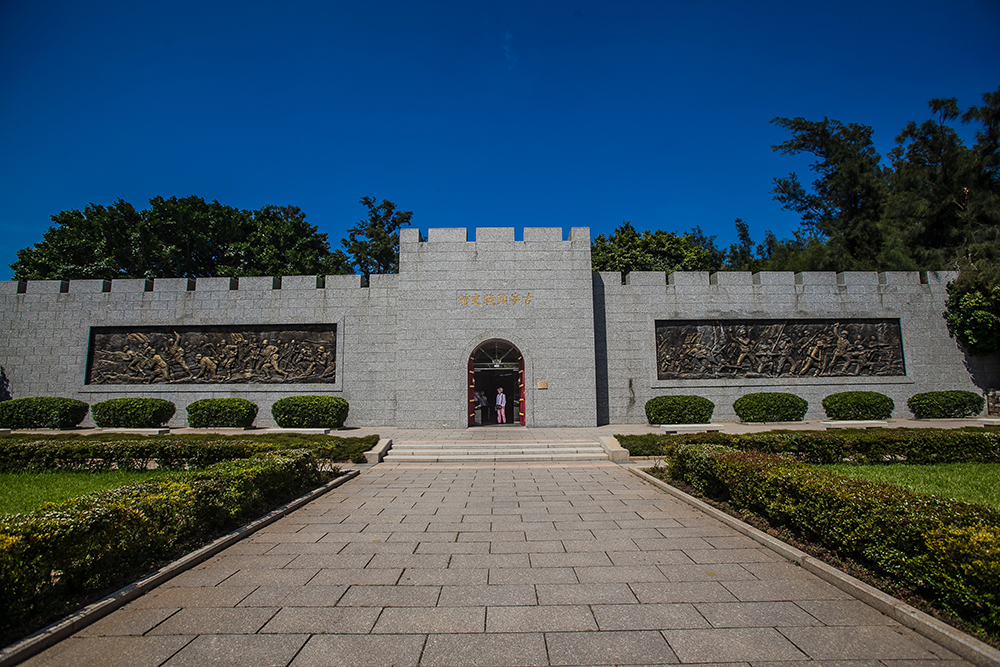
If time allows, I heartily recommend a jaunt to the nearby Beishan Broadcasting Wall, a startling, bizarre sight. Standing atop a cliff, overlooking the sea and the Xiamen area on the other side, this is a tall, narrow concrete broadcasting station with 48 huge loudspeakers fitted into its seaside face. Long used to hurl propaganda, it’s said, up to 25km, today only soothing golden-oldies pop songs are lofted across. The rocky, cliff-bottom beach here, easily reached, is both wonderfully photogenic and secluded.
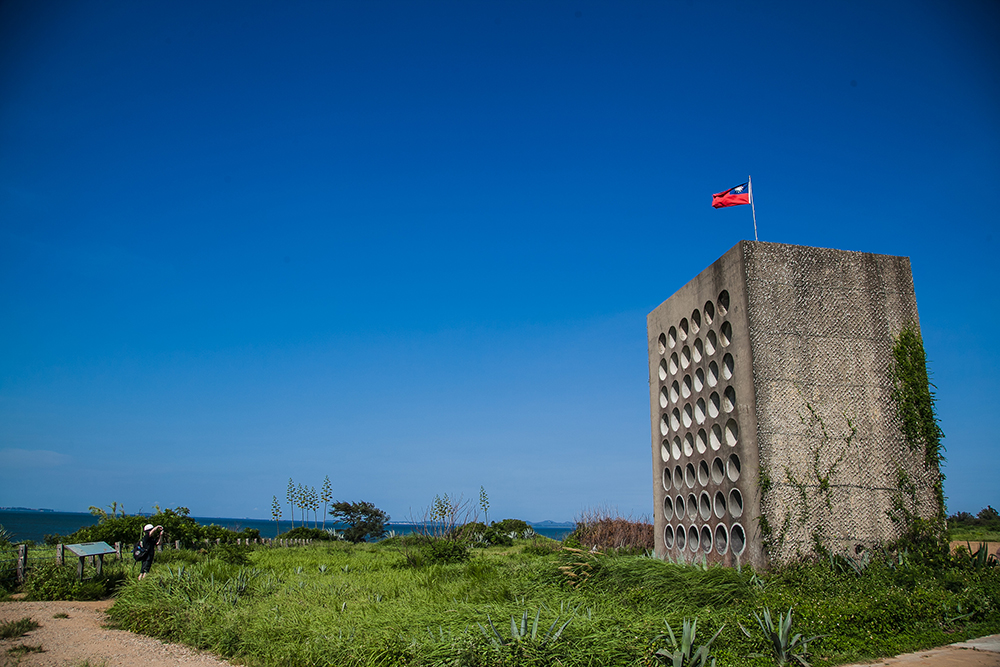
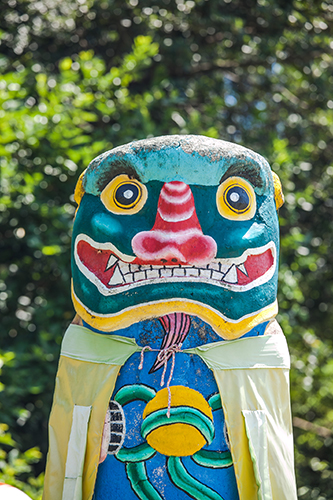
Wind Lion Gods
The Wind Lion God statue is a defining, and conspicuous, manifestation of local islanders’ religious life. According to popular lore, in the late Ming Dynasty (1368–1644) the archipelago was left largely bereft of tree cover when Koxinga, celebrated defender of the Ming empire against the invading Manchu Qing, used Kinmen as his source of wood for his massive fleet. His base before jumping to Taiwan in 1662 to boot out the Dutch colonialists ensconced there was the archipelago’s city of Xiamen. In truth, local tour guides will inform you, the process of deforestation had already long been underway; an extensive system of salt pans had been built, and much land cleared for farms. To counter the often fierce unchecked winds that made agriculture more and more difficult, locals set up wind lion gods at strategic points to deflect the gusting thrusts, for the lion is believed to both ward off evil and attract good fortune.
Southwest to Northeast
On this day, we enjoyed a leisurely jaunt from the tip of the southwest to Kinmen’s closest point to the China mainland, in the northeast, with a dip into the southeast quadrant, finishing with a quick zip to the airport for our evening flight home. Our first stop was a special place I, a history buff, have read about many times and was excited to finally see, the Zhaishan Tunnel. This impressive V-shaped tunnel, with a side tunnel that leads to a third mouth on the crashing sea, was hewn almost solely by hand out of solid granite within a seaside hill-and-cliff over a five-year period in the 1960s. It was used as a safe harbor for supply boats making the hazardous run to and from Taiwan’s main island, with a capacity for 42. An information display is provided outside the tourist entrance, but best of all is the outdoor exhibit of anti-aircraft guns, supply boats, and other decommissioned equipment.

The southeast’s Lake Tai, a great spot for watching both migratory and endemic birds, is Kinmen’s largest artificial lake. A pavilion stands out on island in the lake, making for picturesque views, reached via a long causeway topped by a pathway. Make sure to visit the attractive Ming Dynasty residence that has been excavated and restored in the park beside.
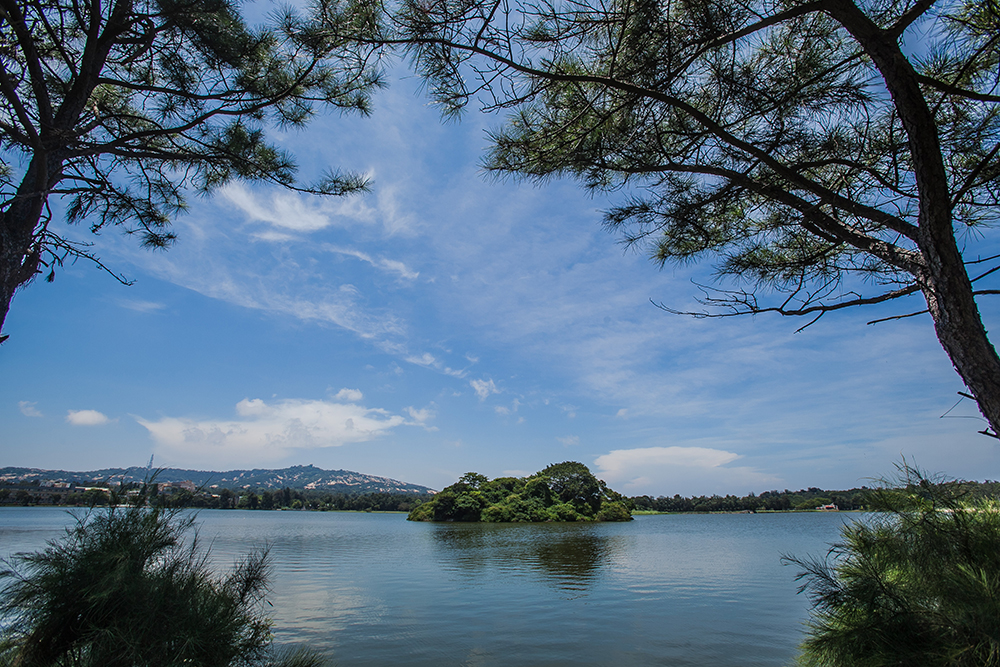
The Mashan Observation Station is Kinmen’s closest point to communist China, on a narrow peninsula at the northeast’s tip. The station is still operational, reached by a long tunnel, and it’s quite a thrill looking across the 2,100-meter stretch of open water at the other side – the distance shrinks to just 1,800 at low tide. While peering at the mainland through the bunker’s high-powered binoculars, think of the young men posted at these coastal spots during the martial-law period, nervously watchful through the dark nights for dreaded visits by trophy-hunting enemy frogmen. Incongruously, the west side of the peninsula base offers up lovely coastal-sunset shots.
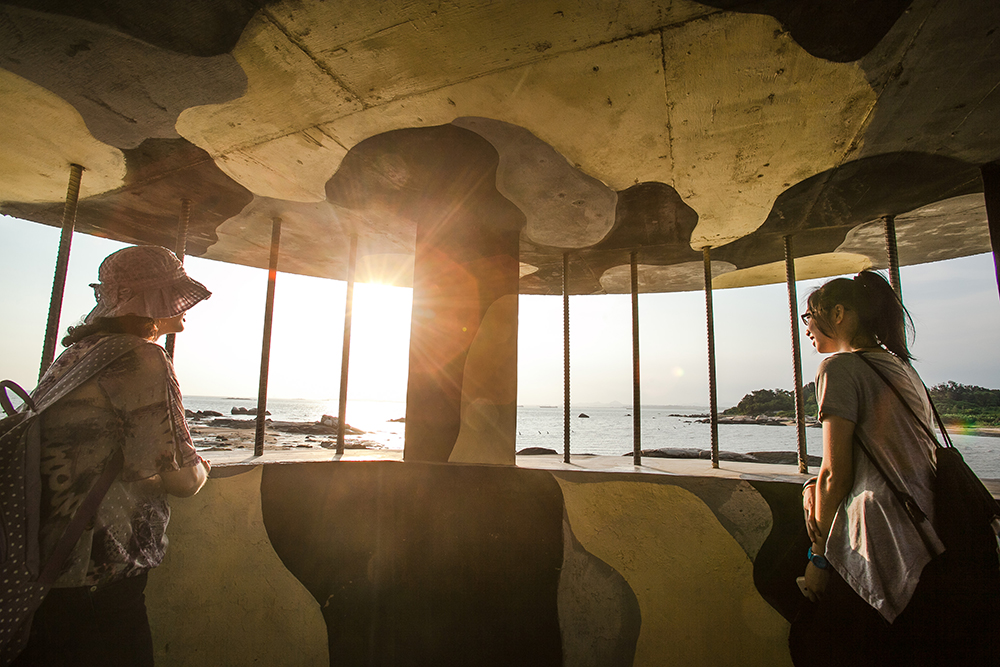
Bicycle Touring
The county government and Kinmen National Park administration actively promote eco-friendly bicycling, offering free bike hire. Government bikes may be borrowed for three days (park bikes for one day) simply by showing your ID. Helmets must be worn and bikes returned to the same location from which they are taken. The flat, shady terrain makes bicycling on the peaceful public roads a pleasure everywhere, but specially recommended is the expansive Sun Yat-sen Memorial Forest, which has a shop offering free bikes and is free of motor vehicles.
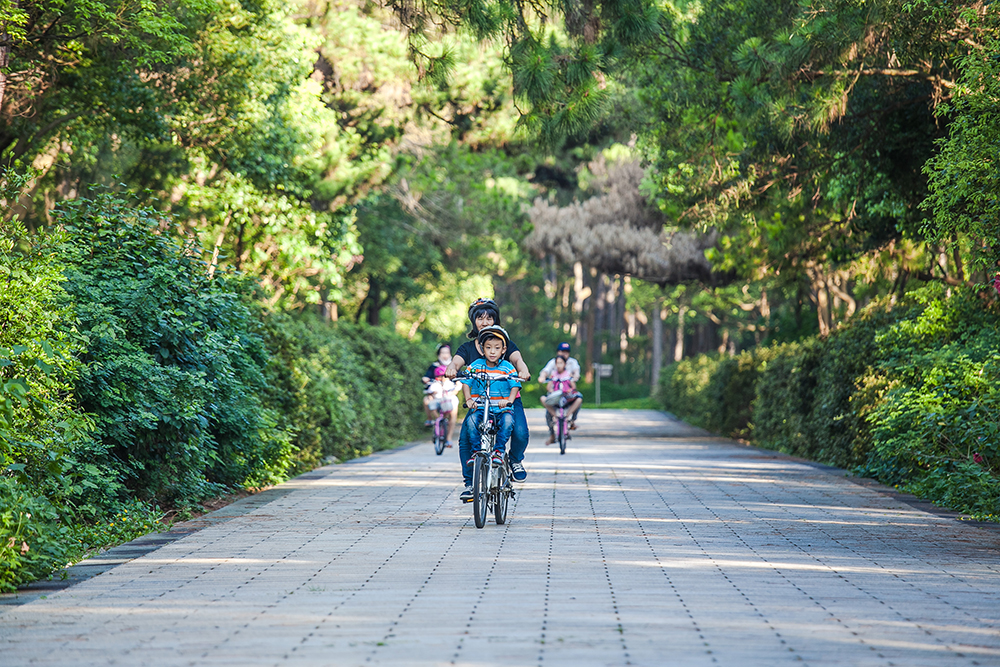
Info
There are regular daily flights to Kinmen from Taipei and other points on Taiwan’s west coast. Advance booking is advised, especially in summer. For details on travel to/from and around the islands, visit the Kinmen Travel website (kinmen.travel/en) and Kinmen National Park website (www.kmnp.gov.tw).
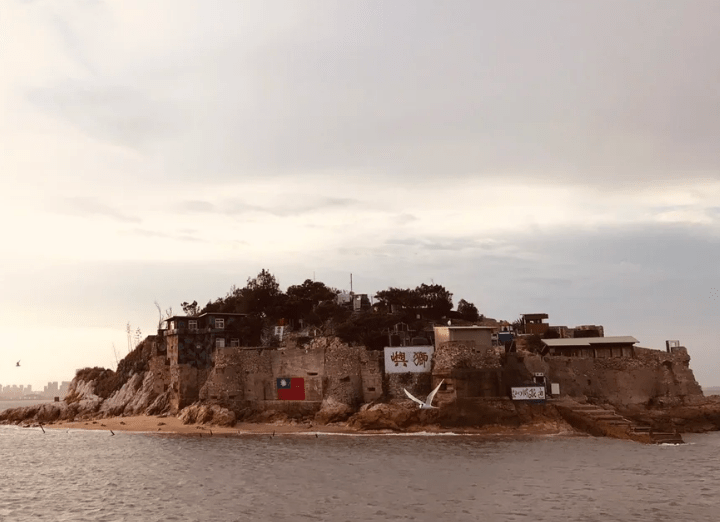
About the author

Rick Charette
A Canadian, Rick has been resident in Taiwan almost continually since 1988. His book, article, and other writings, on Asian and North American destinations and subjects—encompassing travel, culture, history, business/economics—have been published widely overseas and in Taiwan. He has worked with National Geographic, Michelin, APA Insight Guides, and other Western groups internationally, and with many local publishers and central/city/county government bodies in Taiwan. Rick also handles a wide range of editorial and translation (from Mandarin Chinese) projects.


